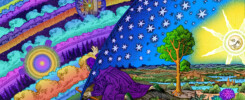The Book of Remembrance is a collection of revelations received by a prophet named David, within the context of the Latter Day Saint Movement, though separate from any of the traditional churches found within said movement. The sub movement is referred to as the “Fellowship” in the text. The revelations cover a wide range of theological and practical matters.
Divine Authority and Revelation
The central theme is the reception and recording of divine revelations from “the Lord,” identified as “YHVH of Elohim—yea even Jesus Christ” (Revelation 4:1). David is presented as a prophet called by God, ordained through various means including angelic ministration and the witness of Jesus Christ (Remembrance 1:1-2). The book itself is described as “a collection of revelations from the Lord unto the prophet David” (Remembrance 1:1). The revelations address questions and needs within the community, providing guidance on doctrine, practice, and organization. Emphasis is placed on hearkening to the “Word” of the Lord, which is described as “quick and powerful, sharper than a two-edged sword” (Revelation 4:2).
Nature of God and Jesus Christ
In the revelations, God is referred to by various names, including Lord, Elohim, YHVH, and Jesus Christ. These names appear to be used interchangeably or in close association, suggesting a unified divine being. Jesus Christ identifies himself as “the Great I AM, YHVH… I created I the heavens and the earth” (Revelation 23:62). He also states, “I was even with the Father from the beginning; I am the light and the life of the world” (Revelation 23:63). The idea of multiple creations or that there are other parts of this creation outside the know scope of our world is touched upon, stating that “Worlds without number have I created; and these were created for a purpose, and by the Son, YHVH were they created; which is Jesus Christ” (see Remembrance 2:1-4). The Father and the Son are often mentioned together, such as in the dedication: “may we be one, even as the Father and the Son are one” (Dedication).
Salvation and the Covenant
Salvation is presented as being found in Jesus Christ, and His “grace is sufficient to save all who will come unto me” (Revelation 6:15). The concept of a “New and Everlasting Covenant” is also mentioned in these revelations (see Revelation 9:20, 10:50, 25:28, 41:6). Emphasis is placed on turning away from sin and walking the path of righteousness, as exemplified by Adam and Eve. Baptism is discussed, with allowance for baptism based on the “desires of their hearts” for those already baptized with authority (Remembrance 1:15).
Organization and Practices
The Fellowship is addressed as a distinct body, though related to the broader Church of Christ and specifically the movement called Church of Jesus Christ of Latter Day Saints. David’s role is significant, being called as a prophet and potentially a successor to figures like James J. Strang (see Revelation 41). The concept of Levites and their role in the Low or Levitical Priesthood is introduced (see Revelations 21 and 35). Levites and those called to the Low Priesthood are to be “peace keepers and the mediators of my Word” and impartial judges (Revelation 33:16). The existence of a “Sisterhood of Christ” and “Brotherhood of Christ” is mentioned, with a revelation addressing those who identify as nonbinary as being “of the middle line of the tree” (see Remembrance 29).
Temple ordinances and endowments are discussed, with the Endowment being described as preparing individuals for service and exaltation, an “invitation to join the Church of the Firstborn and be one with God” (see Remembrance 14:15). Garments of the Priesthood are referenced, with symbolic meanings associated with different parts of the body (see Remembrance 12-13). Members are permitted to purchase garments from other Latter-day Saint branches but should discontinue wearing them if they leave that branch (Notes following Revelation 4).
Relationship with Other Latter Day Saint Branches
The revelations acknowledge the existence and work of other branches of the Church of Christ, including the Reorganized Church of Jesus Christ of Latter Day Saints (now Community of Christ), the Church of Jesus Christ of Latter-day Saints and others. While the Fellowship is presented as distinct, members are allowed to retain baptisms and keys from other branches (Notes following Revelation 4). There is a caution against condemning other branches and an emphasis on focusing on the work of the Fellowship (Revelation 6:15-19). Revelations given to other branches are to be respected within their context.
Mormon Kabbalah
In a revelation received in Ohio on May 19, 2022, it is stated that when David was “given the Book of Remembrance [in 2016] it was unknown to thee that I was teaching thee the mysteries of Kabbalah” (see Remembrance 29:19). This indicates that the book contains Kabbalistic teachings, in spite of the fact that David was initially unaware. Later, in March 2018, while praying on the direction of The Church of Jesus Christ in Christian Fellowship, the Lord told David to “Unite my people in Kabbalah” (2 David 3:9). This reveals a deliberate intention for Kabbalah to play a unifying role to those associated with the book.
After studying Kabbalah, David realized that the revelations in The Book of Remembrance were Kabbalistic teachings, and that these revelations were themselves a Kabbalistic book (2 David 3:11). This confirms the Kabbalistic nature of the book’s content. The Lord further elaborated on the meaning of Kabbalah, stating that it is “all these and more: Yea, Kabbalah is a mysticism, a theology, and a thaumaturgy; Kabbalah is the tradition of Israel, it is my doctrine, and thus it is a mysterious art” (Revelation 47:7-8). Through its revelations and teachings, the Book of Remembrance serves as an introduction to Kabbalistic concepts within a Mormon context, introducing the world to something somewhat unique, Mormon Kabbalah.
The Tree of Life
These revelations explicitly links the tree of life to the mysteries of Kabbalah. With the tree rest the Ten Sefirot, representing the divine attributes of mankind calling down from the heavens and declaring the Glory of God. The Sefirot are structured on the tree: the masculine (left) with Da’at (Father) at the top and Gevurah (Holy Ghost) below; the feminine (right) with Chokhmah (Mother) at the top and Chesed (Son) below; and in the middle, Keter (Crown) at the top with Binah (Understanding) hidden amongst the top branches. The book associates days of creation and certain concepts with the Sefirot on the tree of life:
- Chesed (Mercy) with the first day
- Gevurah (Strength) with the second
- Tif’eret (Beauty/Compassion) with the third
- Netzach (Eternity/Victory) with the fourth
- Hod (Glory/Submission) with the fifth
- Yesod (Foundation/Desires) with the sixth
- Malchut (Kingdom/Exaltation) with the seventh.
Keter, Da’at, Chokhmah, Binah (Understanding) rest above the creation, with Binah connecting mankind to the infinate understanding of God. En Sof (Everlasting), the tree herself, is from before the creation yet is the creation. The nine Sephirot are mentioned as a means to gain Keter (the Crown) in the Holy Temple.
The middle line of the tree represents those who identify as neither male nor female, or both. The image of the tree is used symbolically, particularly in relation to gender identity. Kabbalistic terms like Sephirot and Keter (the Crown) are introduced in relation to accessing glory in the Holy Temple. The nine Sephirot are mentioned as a means to gain Keter and access “God’s Chesed (Mercy)” (Chapter 19:25-16).
The Role of Women
The Sisterhood is recognized as a distinct and important part of the community. Revelations are given to women, such as Victoria, who is called as an Apostle (shaliaḥ) and a daughter of Zion to gather other women (see Revelation 29). There is a critique of patriarchal dominion that has oppressed the daughters of YHVH in Revelation 55:22. The concept of a Matriarchy is mentioned alongside the Patriarchy within the context of priesthood in Revelation 35. The Law of Sarah is mentioned in relation to the presidency of the Sisterhood in Chapter 13, and Priestesses are envisioned as part of a holy nation in Revelation 44:9. These revelations seem to indicate that women do not merely share separate but equal roles, but are required and are even essential for the Latter Day Saint movement to move forward.
Dreams, Visions, and Spiritual Gifts
The text itself begins with a section heading “Dreams and Visions,” suggesting their importance as a means of receiving divine communication. David recounts his own experiences with visions and angelic visitations (see the Dreams and Visions section). Spiritual gifts are acknowledged, including prophecy, healing, hospitality, and the gift of discernment. The use of a seer stone and its relationship to the urim and thummim are explained in Revelation 49. The seer stone is described as “gazelem, bringing light in the darkness” (Revelation 49:16).
Teshuvah (Return or Repentance)
The concept of teshuvah, a Hebrew term for repentance and returning to the path of God (Israel), is emphasized as a crucial aspect of spiritual growth throughout the book. Teshuvah is particularly emphasized for those who have strayed or committed “adultery” against God by forsaking Him (Remembrance 36:31). The Lord warns those who know Him and yet abandon Him, stating they will be left alone until they return in teshuvah to their first love.
While the text states that salvation comes through Christ (Chesed, Mercy), teshuvah is a necessary response to that salvation. The revelations encourage a daily practice of teshuvah. This suggests that teshuvah is not just a one-time event but an ongoing process of self-reflection and realignment with God’s will. While often translated as repent, teshuvah in this text appears to emphasize a more active turning back and a commitment to righteousness, aligning with the Hebrew meaning of “return.”
Unity and Avoiding Division
A recurring theme is the importance of unity among the Saints: “may we be one, even as the Father and the Son are one” (Dedication).
The Lord asks, “Are ye one? Behold, I say unto thee: Nay,” expressing disappointment in divisions (Revelation 25:5). The call to teshuvah is linked to the call for unity among God’s people. Pride and contention hinder this unity, and teshuvah involves dealing justly with one another. To find this unity, the book encourages all Christians to Work together “for the sake of the heavens” to avoiding division (Revelation 24:11).
Conclusion
The Book of Remembrance present a complex theological framework centered on new revelations received by David. It draws upon Latter Day Saint history and terminology while introducing distinct concepts and organizational structures for the Fellowship. Key themes include the nature of God, the path to salvation, the importance of unity, the roles of priesthood and the Sisterhood, and the ongoing guidance provided through revelation, dreams, and spiritual gifts. The text also engages with Kabbalistic ideas and offers interpretations of scripture and historical events within its unique revelatory context.


